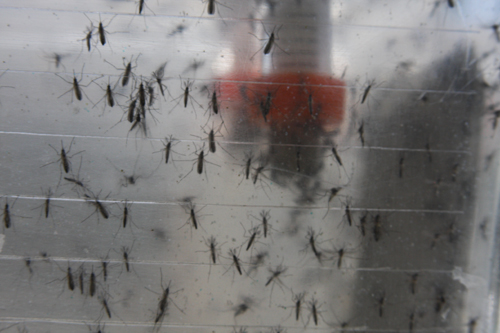This winter’s unusually cold temperatures may have people wondering — or hoping — that Georgia’s insect populations will shrink this spring. That’s just wishful thinking.
As a UGA Extension entomologist, I often receive questions about what Georgia’s winter weather will mean for the spring insect populations. Some times people are worried that the mild winter will mean large populations. Other times people are hoping that a severe winter will be mean smaller populations.
The truth is that insects have been in existence for over 300 million years. As a result of their long history and widespread occurrence, insects are highly adaptable and can survive and thrive in extreme weather conditions. Native insects can usually withstand significant cold spells, particularly those that occur in the heart of winter. Vast regions of the northern-most latitudes are well known for their extraordinary mosquito and black fly populations despite having extremely cold winter conditions.
How do insects survive such unpleasant conditions? Most have adapted their life cycles to avoid activity during cold snaps.
The Monarch Butterfly migrates to warmer areas, but most insects use other techniques to survive the cold. In temperate regions like Georgia, many insects overwinter either in a protected area or in a more protective life stage.
Many mosquitoes, for instance, overwinter in the egg stage. The common, urban-dwelling tiger mosquito (Aedes albopictus) hatches in the spring when temperatures are warmer and water levels are sufficient. Other insects take advantage of protected areas during the winter. For instance, adult Culex mosquitoes — like the Southern house mosquito — overwinter in storm drain systems. Other insects overwinter as larvae or pupae in the soil, which insulates them from the most extreme temperatures.
Insects also undergo physiological changes that help them survive the cold. During the fall, the gradual decline in temperatures and shortening day length, trigger these changes. As the temperature drops below each insect’s ideal range, the insect becomes less active until it eventually can’t move.
The primary thing insect have to avoid is ice crystals forming inside their body. Ice crystals commonly form around some type of nucleus. As a result, overwintering insects commonly stop feeding to keep food material out of their gut where ice crystals can form. This reduction in feeding will also result in a reduction in water intake.
Insects that can tolerate the coldest of temperatures often convert stored sugars (glycogen) to glycerol, a sugar alcohol that serves as a type of insect antifreeze. This lowers the insect’s freezing point to well below freezing, a condition described as supercooling. When this occurs, the insect can withstand extremely cold temperatures for extended periods.
Even with all these adaptations, some insects will die over the winter, but most survive. Georgia snow storms or not, most insect populations will re-emerge in the spring. Local conditions related to moisture and overall seasonal temperatures in the spring will have a larger impact on insect populations than this winter’s freezing temperatures.
For more information about insects in Georgia and pest control, visit www.caes.uga.edu /publications.








